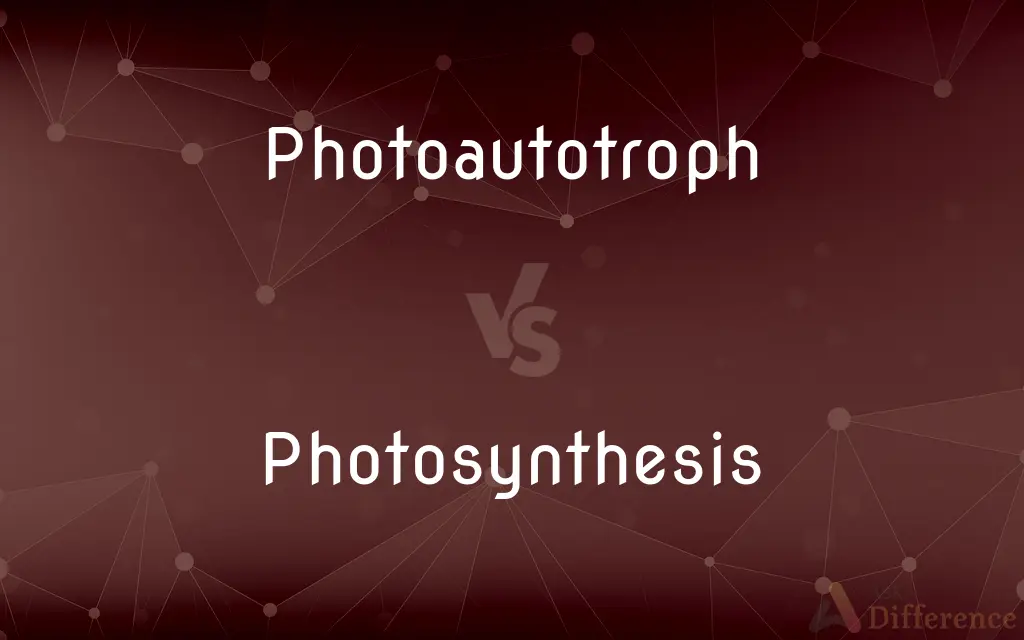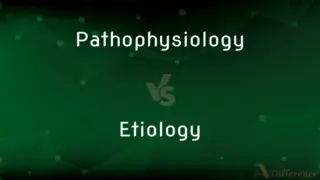Photoautotroph vs. Photosynthesis — What's the Difference?
By Tayyaba Rehman & Urooj Arif — Updated on April 23, 2024
Photoautotrophs are organisms that produce their own food using light energy, typically through the process of photosynthesis, which is the specific biochemical process these organisms use to convert light energy into chemical energy stored in glucose.

Difference Between Photoautotroph and Photosynthesis
Table of Contents
ADVERTISEMENT
Key Differences
Photoautotrophs, such as plants, algae, and some bacteria, are organisms that harness light energy to synthesize organic compounds from inorganic substances like carbon dioxide and water. This capability defines their mode of nutrition, which is self-sustaining and fundamental to ecosystems. Photosynthesis, on the other hand, is the actual metabolic process carried out by these photoautotrophs. It involves the absorption of light, primarily by chlorophyll, and the conversion of this energy into glucose, which serves as a vital energy store for the organism.
In photosynthesis, light energy is captured and used to convert water and carbon dioxide into oxygen and glucose during a series of reactions known as the light-dependent and light-independent (Calvin cycle) reactions. Photoautotrophs possess the cellular structures, such as chloroplasts in plants, that facilitate this complex conversion process. This distinction highlights that while all photoautotrophs perform photosynthesis, the term "photosynthesis" specifically refers to the chemical process rather than the organism.
The role of photoautotrophs extends beyond individual survival to ecosystem support, as they are primary producers and form the base of the food chain. Photosynthesis contributes not only to the food available within an ecosystem but also influences global oxygen levels and carbon cycles, which are critical for life on Earth.
In terms of energy conversion, photoautotrophs efficiently convert solar energy into chemical energy, which can be stored and used when sunlight is not available. The efficiency and mechanisms of photosynthesis, including variations like C3, C4, and CAM pathways, have evolved to optimize energy capture and use in different environments.
The study of photoautotrophs and the photosynthetic process is vital for scientific fields such as agriculture, environmental science, and bioengineering, as understanding these processes can lead to advances in crop production, biofuels, and ecological conservation.
ADVERTISEMENT
Comparison Chart
Definition
Organisms that produce their own food using light energy
Process by which light energy is converted into chemical energy
Function
Synthesize organic compounds from inorganic ones
Converts solar energy into glucose and oxygen
Role in Ecosystem
Primary producers, basis of food chains
Provides energy and oxygen, supports life globally
Key Structures
Chloroplasts in plants and other organelles in different photoautotrophs
Involves pigments like chlorophyll, and processes in the thylakoid membranes and stroma
Biological Importance
Sustain themselves and provide energy for other organisms
Crucial for carbon cycle, oxygen production, and energy flow in ecosystems
Compare with Definitions
Photoautotroph
Use photosynthesis to convert light energy to chemical energy.
Algae, using sunlight, produce nutrients essential for aquatic food webs.
Photosynthesis
Occurs in two main stages: light-dependent reactions and the Calvin cycle.
The light reactions generate ATP and NADPH used in the Calvin cycle.
Photoautotroph
Essential for energy input into ecological systems.
Cyanobacteria are photoautotrophs contributing to nutrient cycling in water bodies.
Photosynthesis
Critical for oxygen production and carbon dioxide reduction.
Photosynthesis in forests globally contributes to oxygen supply.
Photoautotroph
Organisms that synthesize their own food from light.
Green plants are photoautotrophs that supply food and oxygen to many ecosystems.
Photosynthesis
The process of converting light energy into chemical energy.
Photosynthesis in plants involves turning sunlight into glucose.
Photoautotroph
Vary in type and habitat, from land plants to aquatic algae.
Phytoplankton are photoautotrophs critical to marine environments.
Photosynthesis
Adapted in different forms like C3, C4, and CAM to suit various environments.
Cacti use CAM photosynthesis to minimize water loss.
Photoautotroph
Possess specialized structures like chloroplasts.
Plant leaves contain chloroplasts crucial for photosynthesis.
Photosynthesis
Involves pigments like chlorophyll to capture light.
Chlorophyll in chloroplasts captures sunlight for energy.
Photoautotroph
See phototroph.
Photosynthesis
Photosynthesis is a process used by plants and other organisms to convert light energy into chemical energy that, through cellular respiration, can later be released to fuel the organism's metabolic activities. This chemical energy is stored in carbohydrate molecules, such as sugars and starches, which are synthesized from carbon dioxide and water – hence the name photosynthesis, from the Greek phōs (φῶς), "light", and sunthesis (σύνθεσις), "putting together".
Photoautotroph
(biology) an organism, such as all green plants, that can synthesize its own food from inorganic material using light as a source of energy
Photosynthesis
The process in green plants and certain other organisms by which carbohydrates are synthesized from carbon dioxide and a source of hydrogen (usually water), using light as an energy source. Most forms of photosynthesis release oxygen as a byproduct.
Photosynthesis
(biology) Any process by which plants and other photoautotrophs convert light energy into chemical energy,
Photosynthesis
Principally, oxygenic photosynthesis, any process by which plants and algae convert water and carbon dioxide into carbohydrates and waste oxygen using solar energy.
Photosynthesis
Also, non-oxygenic photosynthesis, used by purple and green bacteria, heliobacteria, and acidobacteria.
Photosynthesis
The process of constructive metabolism by which carbohydrates are formed from water vapor and the carbon dioxide of the air in the chlorophyll-containing tissues of plants exposed to the action of light. It was formerly called assimilation, but this is now commonly used as in animal physiology. The details of the process are not yet clearly known. Baeyer's theory is that the carbon dioxide is reduced to carbon monoxide, which, uniting with the hydrogen of the water in the cell, produces formaldehyde, the latter forming various sugars through polymerization. Vines suggests that the carbohydrates are secretion products of the chloroplasts, derived from decomposition of previously formed proteids. The food substances are usually quickly translocated, those that accumulate being changed to starch, which appears in the cells almost simultaneously with the sugars. The chloroplasts perform photosynthesis only in light and within a certain range of temperature, varying according to climate. This is the only way in which a plant is able to organize carbohydrates. All plants without a chlorophyll apparatus, as the fungi, must be parasitic or saprophytic.
Photosynthesis
Synthesis of compounds with the aid of radiant energy (especially in plants)
Common Curiosities
What is photosynthesis?
Photosynthesis is the process by which photoautotrophs convert light energy into chemical energy, producing glucose and oxygen.
How do photoautotrophs contribute to the ecosystem?
As primary producers, photoautotrophs form the base of the food chain and are crucial for the energy dynamics of ecosystems.
How do photoautotrophs store energy?
Photoautotrophs store energy in the form of glucose or starch, which can be utilized during periods without sunlight.
What differentiates photoautotrophs from other autotrophs?
Photoautotrophs use light as their energy source, whereas other autotrophs, like chemoautotrophs, may use chemical energy sources.
What are photoautotrophs?
Photoautotrophs are organisms that produce their own food using light energy, typically through photosynthesis.
Can all plants perform photosynthesis?
Almost all plants are photoautotrophs and perform photosynthesis, but there are exceptions like some parasitic plants that do not.
Why is photosynthesis important for the environment?
Photosynthesis plays a key role in carbon cycling, oxygen production, and maintaining the balance of gases in the atmosphere.
What are the key stages of photosynthesis?
Photosynthesis includes light-dependent reactions that generate energy-rich molecules, followed by the Calvin cycle that forms glucose.
What is the significance of chlorophyll in photosynthesis?
Chlorophyll is the pigment that absorbs light, initiating the process of photosynthesis in photoautotrophs.
How does photosynthesis impact global climate?
By removing carbon dioxide from the atmosphere and producing oxygen, photosynthesis affects global climate patterns and supports life.
Share Your Discovery

Previous Comparison
Salami vs. Pepperoni
Next Comparison
Pathophysiology vs. EtiologyAuthor Spotlight
Written by
Tayyaba RehmanTayyaba Rehman is a distinguished writer, currently serving as a primary contributor to askdifference.com. As a researcher in semantics and etymology, Tayyaba's passion for the complexity of languages and their distinctions has found a perfect home on the platform. Tayyaba delves into the intricacies of language, distinguishing between commonly confused words and phrases, thereby providing clarity for readers worldwide.
Co-written by
Urooj ArifUrooj is a skilled content writer at Ask Difference, known for her exceptional ability to simplify complex topics into engaging and informative content. With a passion for research and a flair for clear, concise writing, she consistently delivers articles that resonate with our diverse audience.














































